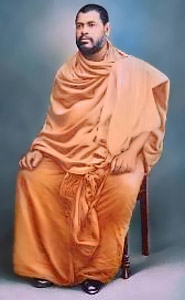 Swami Ramakrishnananda was known as Shashi Bhushan Chakravarthy in his early life. He was born in July 1863. His father Iswar Chandra Chakravarthy was a famous tantric of Hooghly district. He was the eldest son of the family.
Swami Ramakrishnananda was known as Shashi Bhushan Chakravarthy in his early life. He was born in July 1863. His father Iswar Chandra Chakravarthy was a famous tantric of Hooghly district. He was the eldest son of the family.
Since his childhood, Swami Ramakrishnananda was inclined towards the spiritual matters. As a student, he had a brilliant academic record. But, he could not appear for his B.A. Degree examinations and from there starts the second part of his life story.
When Ramakrishnananda or say Shashi Bhushan Chakravarthy was a young lad, Keshab Chandra Sen, the head of the Brahmo movement at Calcutta had cast a spell over the youngsters by his blistering speeches. He also got impressed by what he had heard from others about Keshab Chandra Sen. So, in 1883, one day, he along with his companion Sarat (later to be known as Swami Saradananda) went to meet Sri Ramakrishna Parama-hamsa at Dakshineswar.
Ramakrishnananda then started visiting there regularly and became his disciple. It continued for nearly three years, from October 1883 to August 1886. During the last eight months he became a constant attendant of his guru. Thus, he had to leave his college studies to stay with his guru all the time. He used to bathe him, fed him, fanned him and even cleaned his commode. In 1886, his guru Keshab Chandra Sen left this world. After his death all the disciples were very upset. But later, Narendranath took the leadership and organised all the disciples. They started a monastery at Baranagore, Calcutta and took the monastic names. Thus, Shashi Bhushan Chakrvarthy started a new life as Swami Ramakrishnananda and Narendranath became Swami Vivekananda.
Swami Vivekananda while talking about the life at Baranagore said, "Shashi was the main pillar of the Math. Without him life in the monastery would have been impossible". Therefore, in later period when Madras needed a dynamic Swamiji, Swami Vivekananda referred the name of Swami Ramakrishnananda. He went to Madras in 1897 and at that time he was only thirty-four years old. After reaching there, he first mounted a picture of the Paramahamsa, which he brought from Baranagore. Thus, the Ramakrishna Math was set up in Madras. The math`s first building was a two-storied rented building near the Ice House and which was known as the Flora Cottage. Later, in the month of June, the monastery was shifted to Castle Kernan.
The life at Math was never so easy. The main problem was regarding the funds for the newly born Ramakrishna movement. The situation became worse that sometimes the food was not in enough amounts. Swami Ramakrishnananda was a strong and healthy man and he used all his energy to propagate the message of his Master. He kept himself busy in addressing at various places of the city. At times, the number of lectures went up to three or four per day. He used to travel on bare foot to these places and sometimes allowed himself a cart ride when there was enough money to spend. The schedule of his work used to be much difficult than the topics of his lectures. He was a great scholar and avid reader in Sanskrit. So, apart from the teachings of his guru, he used to address on the chapters from the Gita, Upanishads and so on. He was also a litterateur and authored several books.
One of his great works includes a book on the Life of Sri Ramanuja, which remains till today, one of the noteworthy books on the subject.
Swami Ramakrishnananda followed the moto that `Service of man is equivalent to Service to God`. He launched the `Student`s Home` with seven orphans at a small rented house at Mylapore on February 17 in 1905. This was the beginning of the now well-known Ramakrishna Home.
Soon after the death of Sri Biligiri Iyengar, the owner of the Ramakrishna Math, the infant Madi was left homeless. But luckily, a good person gifted a small plot of land on Brodies Road and the new building of the Ramakrishna Math was inaugurated there on 17th November 1907.
Swami Ramakrishnananda was a wandering sanyasi and he used to give several lectures at the neighbouring places of Bangalore, Kerala, Bombay and even at distant Burma. But, this noble person was attacked by diabetes and then tuberculosis only at the age of forty-eight years. His physical condition did not allow him to live long. He was persuaded to leave for Calcutta and he left Madras for the last time. Swami Ramakrishnananda entered into mahasamadhi on August 21 in 1911.




















